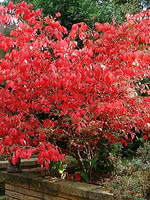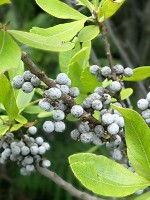Mon-Fri 9am - 5pm Mountain time
Burning Bush vs Northern Bayberry
Euonymus alatus
Myrica pensylvanica
NOT AVAILABLE THIS SEASON - MIGHT RETURN
Burning Bush is a unique shrub whose leaves turn firey red in the fall. You can plant it in rows to make a hedge or on its own. Burning Bush requires little maintenance and thrives in just about any kind of soil, which makes it a good choice for inexperienced growers. Plant it in full sun to get its best fall color.
Select Cultivar: Dwarf Burning Bush is a smaller variety of Burning Bush. This shrub has a compact form and only reaches 4-5ft tall and 4-5ft wide.
Note: Burning Bush is considered an invasive species in eastern North America. Please plant the right tree in the right place.
Northern Bayberry makes an excellent hedge or feature shrub. It will retain its leaves in warmer climates but drops them in colder areas. They produce blue-grey berries that have a wax coating on them that can be used to make candles or soaps.
In colder hardiness zones the leaves turn an attractive orange to red colour in the fall, making it a striking addition to your landscape.
Northern Bayberry is native to Nova Scotia and tolerates both drought and wet conditions. It is also a nitrogen fixer that tolerates poor soil conditions.
Burning Bush Quick Facts
Northern Bayberry Quick Facts
Toxicity: Warning: The wax from bayberry fruit is considered toxic and may be carcinogenic.

